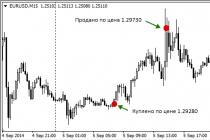[email protected] Irina Aleksandrovna Elkhina,
postgraduate student of the Department of Economic Informatics and Management, UDC 338(470) Volgograd State University
STRUCTURAL SHIFT AND STRUCTURAL DIFFERENCES IN ECONOMIC SYSTEMS IN RUSSIA
The article presents the results of calculations of structural changes in the regions of Russia for the period from 2004 to 2011. in terms of gross value added by type of economic activity. The calculations are based on the Ryabtsev index, the choice of which is explained by the presence of a scale for assessing the measure of the significance of structural differences and the possibility of obtaining adequate estimates on any set of statistical data. Based on the obtained index values, the author identified six groups of regional economic systems, distinguished by identical structure, very low, low, significant, significant and very significant levels of structural differences. To determine the industries in which structural changes occurred due to changes, the mass, speed, and indices of structural changes for the federal districts of Russia were calculated. The agricultural and manufacturing sectors are characterized by negative dynamics according to the indicated characteristics of structural changes. The calculated indices of structural differences in the Russian economic system for a longer period of time (1990 - 2011), covering the ascending and descending phases of the fifth long wave of economic cycles, confirm the presence of structural shifts in the economic systems of the Russian economy.
Key words: structural shift, structural differences, economics of Russian regions, industry structure, gross value added.
STRUCTURAL SHIFTS AND STRUCTURAL DIFFERENCES OF ECONOMIC SYSTEMS IN RUSSIA
The paper presents the results of a statistical survey of the structural changes in the Russian regions for the period from 2004 to 2011 in terms of gross value added according to the type of economic activity. The calculations were obtained using the Riabtsev index which was chosen for having a rating scale for measuring the level of structural differences and the ability to obtain adequate estimates of any set of statistical data. Having obtained the values of the relevant indices the author identifies six groups of regional economic systems: with verylow, low, substantial, significant and very significant level of structural differences. In order to determine the sectors that caused the structural shifts, the author calculates mass, velocity, and indices of structural changes in the federal districts of Russia. The author reveals that there is a negative dynamics in these characteristics of structural changes in the agricultural sector and the manufacturing industry. The calculated indicators of the structural differences of the economic system in Russia for a longer time period (1990 - 2011) cover the ascending and descending phases of the fifth long wave of economic cycles and confirm the presence of structural changes in the economy of the Russian Federation.
Keywords: structural shift, structural differences, regional economy in Russia, sectoral structure, gross value added.
The development of convergent technologies and the formation of a new technological structure has a significant impact on the functioning of economic systems and on the level of socio-economic development of regions. New technologies involved in the creation of a regionally produced product determine the structure of the economy and the predominance of certain industries. In order to determine the presence of transformation processes in regional economic systems, it is necessary to assess structural shifts and structural differences. For this purpose, there are a number of indices: the Herfindahl-Hirschman index, the entropy index, the relative concentration index, the dispersion indicator of market shares, the integral coefficient of structural differences by K. Gatev, the index of structural changes by A. Szalai, the V.M. Ryabtseva.
Each of the indicators has advantages and disadvantages. The Herfindahl-Hirschman index is traditionally
is used to measure production concentration, but is not comparable for structures with different numbers of elements. The entropy index is the inverse of the concentration index and is used less frequently. The dispersion of market shares is a rougher analogue of the above-described indices and is used as an auxiliary tool. The relative concentration index does not have clearly defined limits for its interpretation. The Gatev coefficient, the Szalai index and the Ryabtsev index are the most accurate and convenient tools for achieving the goals set in the study.
The main problem with using indices from socio-economic statistics is the lack of intuitive understanding and, as a consequence, the difficulty of choosing between them. The Ryabtsev and Gatev indices differ only in the denominator, but the lack of a clear interpretation does not allow us to select the best one.
Gatev Index:
Table 1
Salai Index:
Ryabtsev index:
Scale for assessing the significance of structural differences using the Ryabtsev index
Value range 1„ Characteristics of the measure of structural differences
0.000 - 0.030 Identity of structures
0.031 - 0.070 Very low level of structure difference
0.071 - 0.150 Low level of structure difference
0.151 - 0.300 Significant level of difference in structures
0.301 - 0.500 Significant level of difference in structures
0.501 - 0.700 Very significant level of structural differences
0.701 - 0.900 Opposite type of structures
0.901 and above Complete opposite structures
where bu are the specific weights of features in aggregates; ¡ is the number of gradations in structures.
Testing the methodology for calculating structural changes in the sectoral structure of the federal districts of the Russian Federation for the period 2004 - 2011. based on the Ryabtsev, Gatev and Salai indices allows us to conclude that there are structural changes in the regions (Fig. 1).
The reliability of the calculations is confirmed by the fulfillment of the inequality developed by V.M. Ryabtsev:
Ryabtsev index< индекс Гатева < индекс Салаи.
As follows from the results of the dynamics of the indices presented in Fig. 1, the author's calculations are correct.
To further assess the significance of structural changes in gross value added (GVA) by type of economic activity in the regions of Russia, the Ryabtsev index is used due to a number of reasons: 1) the Salai and Gatev indices cannot be calculated if the share of the industry is equal to zero; 2) the Ryabtsev index has a scale for assessing the significance of structural differences (Table 1).
Conducting an assessment study of the structure of GVA of federal districts of the Russian Federation by type of economic activity for the period from 2004 to 2011. allowed us to identify only three levels of structural differences (Table 2).
Table 2
Assessing the significance of structural differences
in gross value added of federal districts for the period 2004 - 2011.
Volga Federal District 0.048 Very low level of differences in structures
Russian Federation 0.060
Central Federal District 0.062
Southern Federal District 0.075 Low level of differences in structures
Ural Federal District 0.077
Northwestern Federal District 0.085
North Caucasus Federal District 0.149
Siberian Federal District 0.168 Significant level of differences in structures
Far Eastern Federal District 0.219
Rice. 1. Graph of the dynamics of structural changes in the Russian economy according to the Salai, Gatev and Ryabtsev indices for the period 2004 - 2011. (compiled by the author based on sources)
The average Russian structure of the economy, the structure of the Central and Volga Federal Districts are characterized by a very low level of difference in structures. A low level of difference in the structures of economic systems distinguishes the Northwestern, Southern, North Caucasus and Ural federal districts. A significant level of difference over a seven-year period is typical for the Siberian and Far Eastern federal districts.
To assess the degree of difference in the structures of the economic systems of the federal districts, the Ryabtsev index was calculated in relation to the structure of the economy of the Southern Federal District (Table 3).
Table 3
Assessment of the significance of structural differences in the gross value added of the Southern Federal District to the federal districts of Russia in 2011.
Region Ryabtsev Index Interpretation
Southern Federal District - Russian Federation 0.218 Significant level of differences in structures
Southern Federal District - Central Federal District 0.298 Significant level of differences in structures
Southern Federal District - Northwestern Federal District 0.224 Significant level of differences in structures
Southern Federal District - North Caucasian Federal District 0.165 Significant level of differences in structures
SFD-VFD 0.246 Significant level of differences in structures
Southern Federal District - Ural Federal District 0.524 Very significant level of structural differences
Southern Federal District-Siberian Federal District 0.264 Significant level of differences in structures
Southern Federal District - Far Eastern Federal District 0.462 Significant level of differences in structures
Based on the obtained data from the Ryabtsev index for federal districts, we can conclude that the sectoral structure of the Southern Federal District of the Russian Federation has a significant level of difference in structure from the sectoral structure on average for Russia. When comparing the structures of the Southern and Ural Federal Districts, the Ryabtsev index has a value of 0.524, which indicates a very significant level of sectoral differences in the compared structures. The Southern Federal District has a significant level of sectoral differences with the Ryabtsev index of 0.462 with the Far Eastern Federal District. When compared with the Central, Northwestern, North Caucasian, Volga and Siberian federal districts, the calculated Ryabtsev index indicates a significant level of difference in structures. The closest to the Southern Federal District in terms of the sectoral structure of the economy is the North Caucasus Federal District, which is explained by territorial-geographical features and the history of the administrative division of Russia into federal districts.
Analysis of the calculated values of indices of structural differences for Russian regions for 2011 in relation to 2004 allows us to identify 6 groups of regions, differing
having identical structure, very low, low, significant, significant and very significant level of structural differences.
Among 92 subjects of the Russian Federation (including federal districts and cities of federal significance), the identical structure of the economy in 2011 in relation to 2004 is noted in the Khanty-Mansiysk Autonomous Okrug.
The group of subjects with a very low level of structural differences includes the structure of the economy on average in the Russian Federation, as well as 5 regions (Nenets Autonomous Okrug, Nizhny Novgorod Region, Tyumen Region, Novgorod and Vologda Regions) and 2 federal districts (Volga and Central).
The largest group consists of regions with a low level of structural differences - 49 subjects, including the general structure of the economy of the Southern, Ural, Northwestern and North Caucasus federal districts. The structure of cities of federal significance - Moscow and St. Petersburg - is characterized by a low level of structural differences.
A significant level of structural differences distinguishes 30 constituent entities of the Russian Federation, including the Siberian and Far Eastern federal districts with their regions, with the exception of the Altai Territory, Tomsk Region, Novosibirsk Region and the Republic of Sakha (Yakutia). In addition, this group includes regions of the Volga Federal District: Kirov (with Ryabtsev index 0.153) and Penza (0.159) regions; regions of the Central Federal District: Kaluga (0.158), Kostroma (0.169) and Lipetsk (0.244) regions; regions of the Southern Federal District: Krasnodar Territory (0.159) and Astrakhan Region (0.187); three regions of the Northwestern Federal District: Arkhangelsk region (0.165), the Komi Republic (0.167) and the Republic of Karelia (0.189); four subjects of the North Caucasus Federal District: Stavropol Territory (0.158), Republic of Dagestan (0.185), Chechen Republic (0.189), Kabardino-Balkarian Republic (0.216).
A significant level of difference in structures over a seven-year period was obtained in two regions: the Republic of Ingushetia - 0.329 and the Jewish Autonomous Region - 0.398.
In general, in the regions of the Russian Federation in 2011, the most significant structural changes were noted in the regions of the Far Eastern Federal District: Sakhalin Region - 0.539 and Chukotka Autonomous District - 0.580. They are part of a group of regions with a very significant level of structural differences throughout the period from 2004 to 2011.
In order to identify industries, due to changes in which transformations in the sectoral structure of gross value added are observed, the mass, speed and indices of structural changes were calculated for the period from 2004 to 2011. by federal districts of the Russian Federation.
Calculated data on the mass of structural shifts in output by economic sectors of federal districts show that for all federal districts and the Russian average, the mass of structural shifts in the agricultural sector is negative, which indicates a decrease in the share of this industry in the overall structure of the gross regional product. The share of manufacturing is also declining. Decrease in the speed and index of structural changes in agricultural sectors
economy and manufacturing confirms the decrease in the share of these industries in the structure of regional economic systems and their stagnation.
The sectors of construction, hotel and restaurant business, real estate transactions, public administration and military security, and healthcare are characterized by positive dynamics. In a number of federal districts there is an increase in the share of the mining sector, with the exception of the Central and Ural Federal Districts and the South of Russia.
In general, the calculation of the characteristics of structural changes by industry for the period 2004 - 2011. does not reveal significant structural differences. However, the assessment of the structures of the Russian economic system for the period 1990 -2011. reveals a significant level of structural changes (Fig. 2).
Six groups of regional economic systems in Russia have been identified, distinguished by an identical structure, very low, low, significant, significant and very significant levels of structural differences;
Based on the calculation of mass, speed and index of structural changes, negative dynamics in the agricultural and manufacturing sectors were determined;
For the period 1990 - 2011. The structure of the Russian economy is characterized by significant structural differences determined by the belonging of economic systems to different phases of the economic cycle, which confirms the influence of new key development factors on the existing system of economic activity.
1. Aralbaeva G.G., Afanasyev V.N. Forecasting structural changes in the sectoral structure of the economy of the Orenburg region
Rice. 2. Histogram of the dynamics of the Ryabtsev index values for GVA by type of economic activity in Russia for the period 1990 - 2011. (compiled by the author based on sources).
The presence of significant structural differences in the economy over the 20-year period under review is explained by a comparison of structures belonging to different phases of the fifth “post-Kondratieff” long wave: the ascending and descending phase. The economy of 2011 is entering a downward phase, the economy of the 1990s. - upward, which determines the presence of a significant level of structural differences in the compared economic systems.
Thus, generalizing the calculations of structural changes and structural differences in the Russian economy, we obtained the following results:
The structure of the economic systems of the federal districts of Russia in 2011 compared to 2004 changed slightly: only two federal districts are distinguished by a significant level of structural differences, the average Russian structure of the economy is characterized by a very low level of structural differences;
region based on a system of econometric equations // OSU Bulletin. 2011. No. 13 (132). pp. 23 - 29.
2. Karpov A.V. Measuring the representativeness of parliament in electoral proportional systems // Modeling in the socio-political sphere. 2008. No. 1 (2). pp. 10 - 21.
3. Polikarpova M.G. Statistical analysis of diversification of integration activity in the Russian economy // Young scientist. 2013. No. 10 (57). pp. 377 - 379.
4. Regions of Russia. Socio-economic indicators. 2007: stat. Sat. / Rosstat. M., 2007.
5. Regions of Russia. Socio-economic indicators. 2010: stat. Sat. / Rosstat. M., 2010.
6. Regions of Russia. Socio-economic indicators. 2013: stat. Sat. / Rosstat. M., 2013.
7. Sadovnichy V.A., Akaev A.A., Korotaev A.V., Malkov S.Yu. Modeling and forecasting of global dynamics. M.: ISPI RAS, 2012.
8. иР1_: https://unstats.un.org/unsd/snaama/Introduction.asp.
The following conditional data are available on the structure of cash incomes of the population of the region, in percentage:
It is necessary to draw a conclusion about changes in the structure of cash incomes of the population.
Solution.
Based on the above indicators, we can conclude that in the composition of the population’s cash income, the share of wages decreased (from 60% in the base period to 42% in the reporting period) with an increase in the share of income from property and business activities (from 24% to 44%, respectively) .
A generalizing characteristic of the measure of structural changes is given by integral indicators of structural differences, the calculation of which is illustrated in the table:
The magnitude of the calculated indicators of structural differences indicates significant changes in the structure of monetary incomes of the population of the region.
Problems 5-6 involve studying the dynamics of indicators, i.e. the intensity of changes in phenomena over time, which are carried out using the following indicators: absolute growth, growth rates, growth rates, the absolute value of one percent of growth, as well as average generalizing indicators.
Depending on the research objective, indicators can be calculated with a variable base of comparison (chain) and with a constant base of comparison (basic).
1. Absolute increase is the difference between the level being compared and the previous or baseline:
chain absolute increase:
base absolute increase: .
The sum of chain absolute increases is equal to the basic absolute increase for the corresponding period of time.
2. Growth rate– a relative indicator characterizing the intensity of development of the phenomenon; it is equal to the ratio of the level being studied to the previous or basic level and is expressed in coefficients or percentages.
chain growth rate: 100;
base growth rate: .
The product of the corresponding chain growth rates calculated in coefficients is equal to the base one.
3. Rate of increase determined in two ways:
a) as the ratio of absolute growth to the previous level (chain) or basic level (basic):
chain growth rate: ![]()
base growth rate: ![]() .
.
b) as the difference between the growth rate and 100%:
T pr = T r -100%.
4. Absolute value of one percent increase is defined as the ratio of the chain absolute increase to the chain growth rate (%) or for each subsequent level - as 0.01 of the previous level of the dynamics series:
5. Average absolute increase calculated using the simple arithmetic average, that is, dividing the sum of chain absolute increases by their number
Average growth rate found using the geometric mean formula:
Average growth rate found by subtracting 100% from the average growth rate:

Calculation methods mid-level Some dynamics depend on its type and completeness of information.
1) in interval series with equal time intervals, the average level is determined by the simple arithmetic mean formula:
2) in interval series with unequal time intervals - according to the weighted arithmetic mean formula (based on the size of the intervals):
3) in moment series with comprehensive data on changes in the moment indicator, the calculation is made using the arithmetic mean of the series levels that remained unchanged for certain periods of time, weighted by the value of the corresponding intervals;
4) in moment series of dynamics with equally spaced levels, the average chronological simple formula is used.
- See also:
Lecture 10_Statistical study of structure.doc
Statistical study of population structure and its changes
The concept of the structure of a phenomenon and its types
Graphical comparative analysis of structure
Indicators of structural changes and differences
Nonparametric methods for structure analysis
Studying the intensity of structure changes using indices
The concept of the structure of a phenomenon and its types
The development of a statistical aggregate is manifested not only in the quantitative growth or reduction of elements of this system, but also in changes in its structure.
Concept structures is very closely intertwined with the concept grouping and classification.
Structure- This is a structure, a form of organization of a system consisting of individual elements and connections between them.

^ Hierarchical (tree) structure is a complex structure formed by successive fragmentation of a system into increasingly homogeneous groups of elements. It consists of several levels (“steps” of crushing).

Basics advantage hierarchical structure lies in its large information capacity (class, subclass, group, subgroup, type, (varieties), traditionality and familiarity of use, good adaptability for various information processing, as well as the ability to create, when coding objects, classification codes that carry semantic load.
Disadvantage is the weak flexibility of its structure and the pre-established order of distribution stages, which does not allow the inclusion of new objects of classification groupings and characteristics in the absence of reserve capacity. As a result, a change in at least one characteristic leads to a redistribution of many classification groups.
The hierarchical structure is characterized not only by the volume fraction of the attribute, but also by additional indicators.
1. Characteristics of the degree of complexity of the structure, namely the number of levels of fragmentation (“order” of the structure).
2. Average order of structure, i.e. the average number of the level, weighted by the shares of the volume of the characteristic, the fragmentation of which was completed at this level. This value characterizes the average number of fragmentations of the volume of the attribute.
3. The total number of finite (i.e., not further split) branches of the structure.
4. The average number of terminal branches per level.
Balance(fr. balance- literally scales, balance) is a special form of comparison of the structure of the same characteristic value, characterized from two different sides or in two different aspects.
In its most general form, a dynamic balance consists of four components: stock at the beginning of the period, income for the period, expense for the period, stock at the end of the period.
Beginning stock + receipts = expense + ending stock.
For analytical purposes, each of the four components is divided according to various classification criteria into parts, groups or subgroups.
If the total volume of a characteristic is subdivided according to one grouping characteristic, and then each group and total volumes are again subdivided according to another grouping characteristic, then multidimensional, in the simplest case - two-dimensional structure with overlapping characteristics.
The two-dimensional intersecting structure allows the calculation of five types of structural indicators (shares). With three intersecting grouping characteristics, the number of different types of structures reaches 19. In general, with n intersecting features, the structure contains ( n 3 - n 2 + 1) types of shares.
Faceted classification method is a method in which a given set is divided into groups independently, according to various criteria. It does not have a rigid structure and pre-constructed final groupings. With it, a set of objects characterized by a certain set of characteristics (facets) that are identical for all objects can be divided repeatedly and independently. In classifiers, facets are most often arranged in the form of a simple enumeration and have a code.
Basics advantage facet classification - flexibility of the structure of its construction, since changes in any of the facets do not affect the others. The facet classification method allows not only to form new classification groups from existing facets, but also to include new ones in the classifier without modification and exclude old facets.
Disadvantage facet classification should be considered insufficiently full use of capacity due to the absence of practically redundant of the possible combinations of facets, the unfamiliarity of the application, as well as the complexity of using this method for manual information processing.
For the purpose of analyzing the structure, as well as comparing two (or more) structures in dynamics, a large number of statistical methods and approaches are used, which can be presented in the form of the following diagram:

^
Graphical comparative analysis of structure
In socio-economic research, situations often arise in which it is necessary to analyze the structures of phenomena or processes over a number of periods. One of the methods of analysis in this case is to consider structural diagrams.
The most common structural diagram is the pie or pie

Figure - Composition and structure of the unemployed by education in 2003, %
This type of diagram is most convenient to use when illustrating the structure of a phenomenon for one, two or three periods, but in practice a situation may arise when it is necessary to compare the structure for 5 or more periods. In this case, you need to use a donut chart.

Figure - Composition and structure of the unemployed by education in 1992. and 2003, %

Figure - Composition and structure of the unemployed by education in 1992, 1998, 2002-2003, %
^
Indicators of structural changes and differences
To assess changes in the structure of the population over time and determine the structures of individual groups, indicators of structural differences and shifts are used. The simplest indicators of structural differences are [page 37, Timofeeva]:
Linear coefficient of structural differences (shifts) or Re index:
![]()
Where d1 , dO- structure of the reporting and base periods, %
P - number of lines.
Shows how much, on average, the structure of the reporting period does not correspond to the structure of the base period. A disadvantage of the indicator is the fact that its value depends on n. If n is small, then the index takes small values and vice versa.
Quadratic coefficient of structural changes:

0 d 100 or 0 100 (if data is measured in %).
The closer the value of the indicators is to 0, the smaller the differences in the structures of the populations being studied; or the smaller the changes that have occurred in the structure of the aggregate in dynamics.
Linear and quadratic coefficients are used mainly to study the dynamics of structure indicators, because clearly allow one to draw conclusions about the intensity of changes in structures in certain periods of time.
^ Gatev Index(Gatev index) distinguishes structures with equal sums of squared deviations.

Ryabtsev index(Ryabtsev index) differs slightly from the Gatev index and takes lower values:

^ Salai Index(Szalai index) was introduced when studying differences in the structure of time budget use among different population groups:

The Salai index differs from all the indices of this group discussed above. It takes values close to one when the total is a large number of units.
The given indices take values in the range from 0 to 1. If one or another index is equal to zero, then complete similarity of structures is observed, if one is a complete difference. If more than 0.5, then the differences in the structure of the reporting and current periods are considered significant.
^
Nonparametric methods for structure analysis
Along with the considered indicator, it is possible to use correlation indicators to take into account the differences (similarities) of structures. But as a rule, it is impossible to use conventional measures of relationships (Pearson’s correlation coefficient), since their use imposes a requirement of normality on the analyzed data. The way out is to apply nonparametric methods to the available data that do not require normality and a large number of population units. Non-parametric correlation measures include the Spearman coefficient, Gamma coefficient, Kendal-Tau coefficient and others.
^ Spearman's rank correlation coefficient is named after the English psychologist who developed this coefficient, Charles Spearman (1863-1945).
First, determine the value:

![]()
The given formula is suitable in the absence of combined ranks. To extend this formula to the case of the presence of combined ranks, it is necessary to determine for each ranking the value:
![]()
Where T n k - number of matching ranks in k-Ouch group (in the absence of combined ranks m= n, n 1 =n 2 =...=n n=1 and accordingly T= 0).
Taking into account the last remark, Spearman's rank coefficient between rankings R x And Ry calculated by the formula:

If T X And T Y are small relative to 1/6( n 3 -n), then you can use an approximate value:

The Spearman correlation coefficient can take values in the range from -1 to +1. The closer this indicator approaches one, the more dissimilar the structures of the reporting and base periods are.
The significance of is assessed using t-statistics.

n (n10).
Null hypothesis H0 n-2 degrees of freedom.
^ Kendal coefficient . To calculate this coefficient, the rank values are required R x arrange in ascending order. The ranks are arranged in accordance with this order. Ry. Then the values are calculated R And T.
If for each rank R y determine the number of rank values following it that exceed its value, then the sum of such excesses is denoted by R.
If for each rank R y determine the number of rank values preceding it that exceed its value, then the sum of such excesses is denoted by T. Next we determine the value S = R - T.
The Capdal coefficient is calculated using the formula:
![]()
For sufficiently large P values and are approximately related by the following relationship, = 1.5.
If there are combined ranks, the Kendal coefficient is determined by the formula:

Where U - correction factors, which are calculated using the formula:
![]()
Where m- number of groups of matching ranks, n k- number of matching ranks in k-th group (in the absence of combined ranks m= n, n 1 =n 2 =...=n n=1 and accordingly U = 0)
The significance of the coefficient is assessed using u-statistics:

Having a normal distribution for a sufficiently large n (n10).
Null hypothesis H0 is that there is no direct correlation between the structure of the reporting and base periods. Therefore, one-sided criterion can be applied when n-2 degrees of freedom.
Counting numbers R And T
For R Y= 1 number of ranks R Y , preceding 1 and more is equal to 0, and following 1 and more is equal to 9,
For R Y = 2 number of ranks R Y , preceding 2 or more is equal to 0, and following 2 or more is equal to 8;
For R Y = 7 number of ranks R Y, preceding 7 and more is equal to 0, and following 7 and more is equal to 3;
For R Y= 5.5 number of ranks R Y ,
preceding 5.5 and more is equal to 1 (with a “-” sign) (this is R Y
= 7), and the number of ranks R Y ,
subsequent ones after 5.5 and more, equal to 3, etc.
| R X | R Y | R | T | Total |
| 1 | 1 | 9 | 0 | 9 |
| 2 | 2 | 8 | 0 | 8 |
| 3 | 7 | 3 | 0 | 3 |
| 4 | 5 | 4 | -1 | 3 |
| 5 | 3 | 5 | -2 | 3 |
| 6 | 4 | 4 | -2 | 2 |
| 7 | 6 | 3 | -1 | 2 |
| 8 | 9 | 1 | 0 | 1 |
| 9 | 8 | 1 | -1 | 0 |
| 10 | 10 | 0 | 0 | 0 |
| Total | TO | 37 | -7 | S=31 |
From the table it follows that the Kendal coefficient is 231/109 = 0.689
^ Studying the intensity of structure changes using indices
The specific task of index analysis is to assess the impact of structural changes on changes in the overall volume of phenomena and average levels of quality indicators.
Option #1. First, the index of the total volume of the phenomenon is decomposed:
I total volume = I volume and structure I qualitative indicator
![]()
I volume and structure = I volume I structure

The final form of decomposition of the total volume index is as follows:
I total volume = I volume I structure I quality indicator
^ Option No. 2. At the first stage, the index of the total volume of the phenomenon is considered as the product of the indices of the volume of the population and the average level of the qualitative indicator:
I volume and structure = I volume I average level of quality indicator
![]()
Since the level of the average value is formed under the influence of the size of the attribute of individual units of the population structure, the change in the average value of the indicator is influenced by both the change in the value of the attribute for individual units and the change in the structure of the population. Accordingly, at the second stage, the average level index is decomposed into a feature size index and a structure index:
I average level of quality indicator = I quality indicator I structure
![]()
Ultimately, the total volume index is decomposed according to the following scheme:
I total volume = I volume I quality indicator I structure
1The analysis of disproportions in employment in the municipalities of the region as a whole, and in the context of large and medium-sized, small and micro enterprises, was carried out using the Ryabtsev Index, the main advantage of which over other methods for measuring shifts in the number of employed population in the regions of the republic is that that its value does not depend on the number of gradations of structures, that is, on the number of municipalities, therefore there is no overestimation of structural changes, and also that there is a scale for assessing the significance of differences in structures according to the index. A comparison of the structural indicators of the average number of employees in large and medium-sized enterprises showed that the processes of gradual reduction of workers in large and medium-sized enterprises had similar dynamics in each territorial entity of the Republic of Mari El, while the small business system not only does not cease to exist, but is also constantly expanding, although Of course, the level of small business development in the Republic of Mari El is still extremely low. Its formation is hampered by the current concentration of production, unstable economic situation, imperfections of the current tax legislation, and weak government support, which makes it necessary to increase the economic efficiency of municipalities.
regional employment structure
employment of the population of municipalities
Ryabtsev index
level of structure difference
1. Bredneva L.B. Study of the structure and structural differences in the economy of the Khabarovsk Territory // Bulletin of the KhSAEP. - 2011. - No. 1 (52). - P. 4-10.
2. Podzorov N.G. Analysis of the influence of factors on the volume and structure of the gross regional product of the Republic of Mordovia [Electronic resource]. - URL: http://sisupr.mrsu.ru/2010-1/pdf/podzorov3.pdf.
3. Republic of Mari El: statistical yearbook “Republic of Mari El” / Territorial body of the Federal State Statistics Service for the Republic of Mari El. - Yoshkar-Ola, 2011. - 464 p.
4. Statva A.L. Geographical analysis of employment of the population of the Omsk region: abstract. dis. ...cand. geogr. Sci. - Barnaul, 2005. - 24 p.
5. Utinova S.S. Employment and the labor market in the conditions of transformation of the Russian economy: abstract. dis. ... doc. econ. Sci. - M., 2003. - 48 p.
One of the main and most difficult tasks of market transformations is the formation of an effectively functioning, dynamic and civilized labor market. The state has ceased to be the only guarantor of employment, and in the current conditions, each person decides for himself whether to work or not. The idea of the role of employment has changed radically. The results and consequences of the transformation of social and labor relations are reflected in changes in the employed population and its structure, which, under the influence of macroeconomic factors, are subject to further distortions that reduce economic activity and quality of life. First of all, this is due to the restructuring of employment due to changes in structure.
To study employment and the processes of its regulation in the region, it is advisable to carry out a typology of its constituent regions, since the Republic of Mari El does not act as a single monolith, but as a set of regions with specific characteristics of employment, priorities and development prospects.
To analyze employment in 17 administrative units of the republic (3 city districts and 14 municipal districts) we used data for two time periods - 2000 and 2010. - values are the following indicators:
- number of employed population (total), people, calculated according to the ILO methodology based on sample surveys on employment problems at the end of the year;
- average annual number of employees at large and medium-sized enterprises, people, calculated according to data from organizations and enterprises for the year;
- average annual number of employees in small and micro enterprises, people, calculated according to data from organizations and enterprises for the year.
An analysis of the total number of employed showed that the majority of the total employed population in both 2000 and 2010. accounted for urban districts: 63.4 and 60.5%, respectively. In 2000, the share of the employed population in the total number of workers was 53.7% - Yoshkar-Ola; 6.6% - Volzhsk, 3.0% - Kozmodemyansk. A fairly large share of the total employed population at that time belonged to the Gornomarisky (4.5%) and Zvenigovsky districts (3.5%).
In 2010, Yoshkar-Ola continued to account for the largest share of workers - 46.2%. But if during the period under study the number of employees in the capital of the Republic of Mari El decreased by more than 18 thousand people, then the cities of Volzhsk and Kozmodemyansk during the time period under study not only expanded their shares in the distribution of workers to 8.2 and 3.8 %, respectively, but also increased the absolute values of the total number of employees in their territory by 28.2 and 32.0%, respectively. Among the municipal districts in terms of the number of people employed in 2010, the leaders were the Medvedevsky district, which provided jobs for 9.3% of the employed population of the republic, and the Zvenigovsky district, where 5.9% of the employed worked. Such disproportions in employment are primarily associated with the geographical distribution of enterprises on the territory of the republic, which are predominantly located in the cities of the region, which, of course, serves as an additional factor in increasing the role of cities in the development of society - urbanization.
An analysis of the average number of employees at large and medium-sized enterprises showed that the reduction of workers in this group occurred everywhere during the study period. The Paranginsky, Mari-Tureksky, Kuzhenersky and Novotoryalsky districts stand out especially, where the growth rates of the analyzed indicator were 34.8, 39.0, 40.2 and 40.7%, respectively. The Medvedevsky district stands out significantly against the general background, in which the reduction in the average number of employees at enterprises of this group amounted to only 9.0%. In 2000, 54.9% of the average number of employees at large and medium-sized enterprises were in cities (Yoshkar-Ola - 42.4%, Volzhsk - 8.3%, Kozmodemyansk - 4.2%). Among the districts, Zvenigovsky (6.2%) and Medvedevsky (9.6%) stood out in terms of the number of employees in large and medium-sized enterprises. A similar situation was observed in 2010.
As for small businesses, the picture here is somewhat different. If in 2000 in the urban districts of the republic 16,013 people were employed in small enterprises and this accounted for 86.3% of the total number of employees in this group (76.4% worked in the city of Yoshkar-Ola), then by the end of 2010 , despite the impressive growth in the number of workers in this group, only 68.8% of the employed remained in cities (58.6% in Yoshkar-Ola). The Medvedevsky and Morkinsky districts have achieved especially significant success in the development of small businesses. If in 2000 their total contribution to the average number of employees of small and micro enterprises was slightly more than one percent, then by 2010 the Medvedevsky district already provided 6.0% of jobs, and the Morkinsky district - 2.2%.
Figure 1 shows the growth rates of the studied indicators for 2010/2000. The Medvedevsky district had the highest growth rates for all employment indicators. Here, the growth of the total number of employees reached 275.6%, which is primarily caused by the formation and development of small businesses, the average number of employees in which increased by 16.4 times. Yurinsky district, on the contrary, against the backdrop of a reduction in total employment by 51.9%, achieved the most insignificant success in the development of small businesses. The growth rate of the average headcount at enterprises of this group was the smallest in comparison with other administrative units of the republic - only 262.4%.
Rice. 1. Growth rate of the average annual number of employeesin the context of municipalities.
The growth rate of the average number of employees in large and medium-sized enterprises of the republic did not exceed 90.9% (Medvedevsky district). In urban districts alone, the average growth rate of this indicator was only 73.0%.
The negative dynamics of this indicator is due, first of all, to the reduction in the number of large and medium-sized enterprises and organizations on the territory of the Republic of Mari El, which in turn is due to the artificial fragmentation of larger enterprises in order to receive benefits or a lighter tax regime, as well as the redistribution of forms of ownership of enterprises in the region . The number of state-owned enterprises in the study period decreased from 861 to 746, of which the republican form of ownership - from 565 to 431.
The problems of small business development both in the country as a whole and in the republic have recently received quite close attention: decrees of the President of the Russian Federation, Government resolutions and decisions of local authorities are issued, various specialized funds and other infrastructure elements are created to support small businesses, since It is small enterprises that occupy a prominent place in the market for goods and services; they are most susceptible to changing conditions, to the introduction of new equipment, and the use of advanced technologies. With the help of individual entrepreneurship, social problems such as the creation of new jobs and other local problems are solved. Over the past ten years alone, the number of small businesses has grown by 542 units, while the average number of employees here has increased by 2.4 times over the same period.
The transition to market relations led to a transformation of the economy, the objective reflection of which is largely determined by the availability of general information about structural changes. The priority of studying structure indicators and their dynamics is determined by the need to present objective, high-quality, most complete information that adequately reflects the analyzed areas of employment to heads of government bodies for making effective management decisions.
At the same time, for adjacent periods of time, discrepancies in the structure of the total working population were interpreted for the most part as “identity of structures” in employment of the population in the context of municipalities, the V.M. index was used. Ryabtseva - integral coefficient of structural differences - criterion , :
 (1)
(1)
where and are the specific gradations of the two structures; - number of gradations.
The advantage of this index over other methods for measuring changes in the number of employed people in the regions of the republic is that its value does not depend on the number of gradations of structures, that is, on the number of municipalities, therefore there is no overestimation of structural changes, and also in the presence of a scale for assessing the measure the significance of differences in structures by index (Table 1).
Table 1 - Scale for assessing the significance of differences in the number of employees according to the Ryabtsev index
|
Range of values |
Characteristics of the measurestructural differencesin employment |
Range of values |
Characteristics of the measurestructural differencesin employment |
|
Identity of structures |
Significant level of structural differences |
||
|
Very significant level of structural differences |
|||
|
Opposite type of structures |
|||
|
0.901 and above |
Complete opposite of structures |
In order to assess the significance of differences in the structure of employment of municipalities of the Republic of Mari El, calculations were made of the values of Ryabtsev indices by year for the time interval from 2000 to 2010 for each of the previously considered employment indicators: number of employed population (total), people; average annual number of employees at large and medium-sized enterprises, people; average annual number of employees in small and micro enterprises, people.
Table 2 - Assessment of the significance of structural differences in employment in municipalities of the RME
|
Period |
Ryabtsev index(employed population, total) |
Interpretation |
Ryabtsev index(employment in large and medium-sized enterprises) |
Interpretation |
Ryabtsev index(employment in small and micro-enterprises) |
Interpretation |
|
Identity of structures |
Identity of structures |
Identity of structures |
||||
|
Identity of structures |
Identity of structures |
Identity of structures |
||||
|
Identity of structures |
Identity of structures |
Identity of structures |
||||
|
Identity of structures |
Identity of structures |
Significant level of structural differences |
||||
|
Low level of structure difference |
Identity of structures |
Identity of structures |
||||
|
Identity of structures |
Very low level of structure difference |
Very low level of structure difference |
||||
|
Identity of structures |
Identity of structures |
Very low level of structure difference |
||||
|
Identity of structures |
Identity of structures |
Very low level of structure difference |
||||
|
Identity of structures |
Identity of structures |
Very low level of structure difference |
||||
|
Identity of structures |
Identity of structures |
Identity of structures |
||||
|
Low level of structure difference |
Low level of structure difference |
Low level of structure difference |
As follows from Table 2, the value of the criterion when comparing structural indicators of the number of employed population for the entire observation period (from 2010 and 2000) was 0.098, which indicates a low level of differences in structures in the number of employed population in the municipalities of the republic.
Over adjacent periods of time, discrepancies in the structure of the total working population were interpreted for the most part as “identity of structures,” which indicates that transformations in the distribution of the number of employed within administrative units proceeded at a very slow pace (Fig. 2).

Rice. 2. Dynamics of structural changes in employment in the republic.
The most significant structural transformations during the period under study characterized small businesses in urban districts and municipal areas.
A “significant level of difference in the structures” employed in small businesses was noted in 2003-2004, when the growth rate of the average number of employees in small and large enterprises in the republic was 125.4%. The Gornomariysky district stood out especially strongly against the general background at that time, in which in just one year the average number of workers in this group increased by more than 8 times, while in the urban districts of the republic small businesses were stagnating.
In the last decade, most administrative units of the region have seen an unusually rapid increase in the number of small enterprises. Constantly changing (small businesses appear quickly, but can quickly go bankrupt), the small business system not only does not cease to exist, but is also constantly expanding, although, of course, the level of development of small businesses in the Republic of Mari El is still extremely low. Its formation is hampered by the current concentration of production, unstable economic situation, imperfection of the current tax legislation, and weak government support.
The need to increase the economic efficiency of municipalities poses new challenges for the territories, primarily related to the choice of a competitive model of the regional economy that makes it possible to make maximum use of the existing potential.
Reviewers:
- Katkov Nikolay Semenovich, Doctor of Economics, Professor, Professor of the Department of Economic Cybernetics of the Mari State University, Yoshkar-Ola.
- Shvetsov Mikhail Nikolaevich, Doctor of Economics, Professor, Rector of the ANO VPO “Interregional Open Social Institute”, Yoshkar-Ola.
Bibliographic link
Sarycheva T.V. STATISTICAL STUDY OF EMPLOYMENT DISPROPORTIONS AT THE MUNICIPAL LEVEL OF THE REPUBLIC OF MARI EL // Modern problems of science and education. – 2012. – No. 4.;URL: http://science-education.ru/ru/article/view?id=6865 (access date: 12/20/2019). We bring to your attention magazines published by the publishing house "Academy of Natural Sciences"
Calculate:
1) the level and dynamics of labor productivity for each enterprise separately;
2) for two enterprises together:
a) average labor productivity index of variable composition;
b) index of average labor productivity of permanent (fixed) composition;
c) index of the impact of structural changes due to changes in the number of employees;
d) absolute change in the volume of production in the second quarter compared to the first quarter as a result of changes in each of the factors.
Show the relationship between the calculated indicators. Analyze the results and draw conclusions.
Solution.
1. Determine the level and dynamics of labor productivity for each enterprise
a) for enterprise No. 1
performance index
Labor productivity at enterprise No. 1 increased by 25.9%.
b) for enterprise No. 2
in the 1st quarter, million rubles. for one person
in the 2nd quarter, million rubles. for one person
performance index
Labor productivity at enterprise No. 2 increased by 24.4%.
2. Let us determine for two enterprises together:
a) average labor productivity index of variable composition:
b) index of average labor productivity of permanent (fixed) composition:
c) index of the impact of structural changes due to changes in the number of employees
Index Relationship
d) absolute change in the volume of production in the second quarter compared to the first quarter as a result of changes in each of the factors
Thousand rub.
Thousand rub.
Thousand rub.
Average labor productivity at two enterprises in the second quarter increased by 22.8% (or 1.13 thousand rubles) compared to the first quarter, including due to an increase in productivity at individual enterprises by an average of 25.1% ( or by 1.22 thousand rubles) and a change in structure by - 1.8% (or a decrease by 0.09 thousand rubles).
Example 2. The following data on the export of metal products from the Russian Federation is known.
Table 39
Export of metal products from the Russian Federation
According to the given data:
a) calculate the price indices and physical volume of exported metal products;
b) determine by what amount (millions of US dollars) export revenue changed under the influence of changes in contract prices.
Analyze the obtained indicators and draw conclusions.
Solution.
a) Transform the aggregate form of the price index
=> => or 91%
Index of physical volume of exported products
=> or 104%
b) absolute change in export revenue due to the influence of changes in contract prices, million US dollars
Metal prices decreased by an average of 9%. The growth in the physical volume of exported metal products amounted to 4%. Changes in contract prices for metal products led to a decrease in export revenue by 434.2 million US dollars.
Example 3. The following data is available on the structure of income (Table 40).
Table 40
Income structure in groups with different average per capita monetary income in some regions of the Russian Federation in 2002.
Determine the significance of structural differences in the incomes of various groups using the Salai and Gatev indices.
Solution. 1. Let's define the Szalai index.
Szalai index I s = ,
Where d 1– income structure in the second group
d 0- income structure in the first group
n– number of groups
We present the calculated data in Table 41.
Table 41
Data for calculating the Salai index
Continuation of table 41
| Property income | -0,74 | 3,34 | -0,2216 | 0,0491 | |
| Other income | 4,6 | 48,9 | 0,0941 | 0,0089 | |
| Total: | - | - | - | 0,2075 |
Thus, the Salai index shows quite significant differences in the distribution of per capita incomes of different groups.
2. Calculate the integral coefficient of K. Gatev:
The calculated data are given in table 42.
Table 42
Data for calculating the integral coefficient of K. Gatev
Thus, K. Gatev’s coefficient shows the differences in the distribution by type of income between the group with low and high per capita income.
Control questions
1. The concept of indices.
2. Individual indices and their types.
3. Main types of economic indices. Aggregate index as the main form of economic index.
5. Relationship between chain and basic indices.














